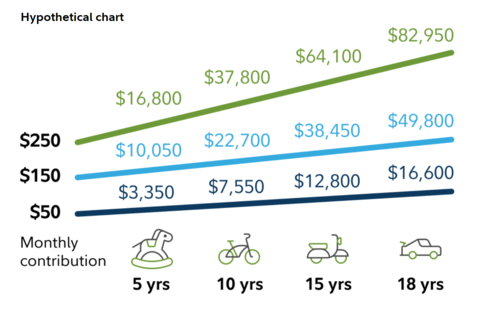While 30% of parents aren’t sure what the full sticker price of college will cost them, 77% of parents agree the value of a college education is worth the cost.
New SECURE Act 2.0 legislation gives families greater flexibility for their 529 savings.
American families say they’re committed to saving for college despite rising costs and the impact of inflation as data from Fidelity Investments® 2024 College Savings Indicator Study reveals saving for college is a priority now more than ever. Nearly 3-in-4 parents (74%) have started saving in 2024 compared to 58% in 2007, when the study was first conducted, and the majority (77%) agree the value of a college education is worth the cost. Even so, 30% aren’t sure what college will cost by the time their child enrolls and more than half (55%) use “their own best guess” to estimate costs.
This press release features multimedia. View the full release here: https://www.businesswire.com/news/home/20240731578979/en/

Source: Fidelity Investments *This hypothetical example illustrates the potential value of different regular monthly investments for different periods of time and assumes an average annual return of 4.5% rounded to the nearest $50. Contributions to a 529 plan account must be made with after-tax dollars. This does not reflect an actual investment and does not reflect any taxes, fees, expenses, or inflation. If it did, results would be lower. Returns will vary, and different investments may perform better or worse than this example. Periodic investment plans do not ensure a profit and do not protect against loss in a declining market. Past performance is no guarantee of future results.
Factors outside of parents’ control continue to weigh heavily on families’ minds. When it comes to saving for their child's education, parents are most concerned about inflation and the rising costs of college (93%), followed by changes to education costs such as free tuition or student debt forgiveness (87%). In fact, more than a quarter of parents (26%) say inflation is the most significant barrier to their ability to save more for college expenses.
“While parents prioritize their children’s college education, the reality is that balancing day-to-day expenses with long-term savings can be daunting,” said Tony Durkan, vice president, head of 529 Relationship Management at Fidelity Investments. “Fidelity encourages parents to save what they can, when they can, with tools such as a 529 plan that offer the flexibility and tax advantages that may enhance a family’s ability to save.”
Parents say that saving for college is their top priority. What’s more, nearly two-thirds (64%) of parents say they have a plan in place to reach their college savings goals. The vast majority (84%) say they’ll either continue their regular college savings contributions or even increase the amount of their regular contributions for the remainder of the year. Regular contributions, even when small, can accumulate over time and help ease the financial burden of rising costs.
Parents Have High Expectations About Paying for College
As the total cost of college continues to rise to more than $41,000 for a public four-year out-of-state institution, parents are increasing the amount they plan to pay for their child’s education. However, while parent’s expectations may have increased, they’re still falling short on funding their intended college savings goal – an important step in long-term financial mobility. Parents hope to pay for 67% of their child’s education, (up from 65% in 2020), but are only on track to meet 30% of that goal (down from 33% in 2020).
New Legislation Makes 529 Plans Even More Flexible
While many parents expect their child to attend some form of higher education, a sizeable 35% admit their child has expressed the possibility of not doing so – leaving many parents questioning the fate of their hard-earned 529 plan savings. Fortunately, new legislative changes may ease some of these concerns, as under certain conditions, 529 plan assets can now be transferred to a Roth IRA for the beneficiary – giving them a retirement boost1. The 529 account must be open for more than 15 years before being eligible for the rollover, which will be subject to annual Roth contribution limits and an aggregate lifetime limit of $35,000. In addition, the transfer amount must come from contributions made to the 529 account at least five years prior to the 529-to-Roth IRA transfer date. This new rule can help 529 account owners avoid taxes and penalties for withdrawals and can be particularly appealing for people looking to help their children get a head start on retirement.
“Leveraging savings tools such as a 529 plan can make a substantial difference when it comes to easing the financial burden for college,” says Durkan. “Thanks to recent legislation like SECURE 2.0, 529 plans have become even more flexible and enticing as a savings vehicle for parents.”
The Importance of Having a Plan
While saving for college is a top priority among parents (and many have a plan for achieving college savings), more than one-third (36%) do not have a financial plan in place to meet their broader goals. As a financial services firm dedicated to helping people live better lives, Fidelity has a long-standing commitment to providing resources and education, to help the next generation make informed financial decisions. Fidelity’s Planning and Guidance Center offers a comprehensive financial tool to help families balance saving for college with other financial priorities. For families who prefer additional support and guidance, financial professionals can be especially helpful – in fact, more than 8-in-10 parents with a financial advisor say working with one gives them peace of mind about the college planning process.
Among those with children nearing college age, two-thirds (68%) believe their child understands how much their total college education could cost, and the total potential amount of student loan debt they may incur, yet 26% have not discussed the total cost of college with their child and 35% have not discussed the amount of student debt that their child may incur following graduation. Simply starting the conversation can help. Fidelity’s study found that most parents who have talked to their child have started saving (80% vs 61%). Additionally, 44% of parents who have talked to their child have opened a 529 account compared to the 29% who have not, and parents who have talked to their child have even saved more on average – $20,000 compared to $12,000 for those who have not had the conversation.
Additional Findings and Resources for College Savers:
- Fidelity is committed to reducing barriers to saving and paying for education. Since 2019, Fidelity’s Goal Booster has been helping employees accumulate savings and better prepare for unexpected financial events. For those who need help starting a goal of saving for college, there is good news—through an integration with Fidelity’s 529 college savings. Goal Booster now helps employees start and reach their savings goals for eligible education expenses, right from their paycheck.
- Nearly three-quarters (71%) of parents agree that concerns about student loan debt is a motivating factor in saving for their children’s college education. Yet parents continue to underestimate the amount of student debt children will incur. To help families understand the true cost of student loan debt, Fidelity offers tools and resources at Fidelity.com/StudentDebtHelp.
- In addition to providing college-planning products and tools, Fidelity has a legacy of supporting its nearly 75,000 associates and the community with access to educational opportunities. Fidelity provides competitive tuition reimbursement benefits, and its student debt benefit to employees. In the community, Fidelity focuses on providing financial education and access to education to historically underserved populations, knowing that education can improve long-term financial mobility. Learn more about career opportunities available at Fidelity today or about Fidelity’s student loan debt assistance benefit.
Need assistance in your college planning? Fidelity can help.
- Call us at 1-800-544-1914 for complimentary access to dedicated college planning representatives
- Get our Viewpoints on college planning at www.fidelity.com/learning-center/life-events/prepare-for-college
- Access our College Savings Resource Center at www.fidelity.com/saving-for-college/overview
- Find a Fidelity Investor Center near you at www.fidelity.com/branchlocator/
- Ask friends and family to contribute to your child’s college savings fund at www.fidelity.com/529-plans/college-gifting
About the 2024 College Savings Indicator Study
As part of the study, Fidelity conducted a survey of parents with college-bound children of all ages. Parents provided data on their current and projected household asset levels including college savings, use of an investment advisor and general expectations and attitudes toward financing their children's college education. Using Fidelity's proprietary asset-liability modeling engine, the company calculated future college savings levels per household against anticipated college costs. The results provided insight into the financial challenges parents face in saving for college. Any mentions of children “nearing college” refer to questions for parents of children either 15 years of age or older or 10th grade and higher. Data for the Indicator (number of children in household, time to matriculation, school type, current savings and expected future contributions) was collected by Boston Research Technologies, an independent research firm, through an online survey from April 15 – May 7, 2024, of 1,985 families nationwide with children high school age and younger who are expected to attend college or other further education. The survey respondents had household incomes of at least $30,000 a year or more and were the financial decision makers in their household. Respondents are weighted to correct for any imbalances between the sample and the population of parents intending to send their children to college. College costs were sourced from the College Board's Trends in College Pricing 2023. Future assets per household were computed by Fidelity Personal and Workplace Advisors LLC (FPWA), a registered investment adviser and a Fidelity Investments company. Within Fidelity’s asset-liability model, Monte Carlo simulations were used to estimate future assets at a 75 percent confidence level. The results of the College Savings Indicator may not be representative of all parents and students meeting the same criteria as those surveyed for the study.
About Fidelity Investments
Fidelity’s mission is to strengthen the financial well-being of our customers and deliver better outcomes for the clients and businesses we serve. Fidelity’s strength comes from the scale of our diversified, market-leading financial services businesses that serve individuals, families, employers, wealth management firms, and institutions. With assets under administration of $14.1 trillion, including discretionary assets of $5.5 trillion as of June 30, 2024, we focus on meeting the unique needs of a broad and growing customer base. Privately held for 78 years, Fidelity employs more than 75,000 associates across the United States, Ireland, and India. For more information about Fidelity Investments, visit https://www.fidelity.com/about-fidelity/our-company.
Please carefully consider the plan's investment objectives, risks, charges, and expenses before investing. For this and other information on any 529 college savings plan managed by Fidelity, contact Fidelity for a free Fact Kit, or view one online. Read it carefully before you invest or send money.
**Units of the portfolios are municipal securities and may be subject to market volatility and fluctuation.**
Keep in mind that investing involves risk. The value of your investment will fluctuate over time, and you may gain or lose money.
Views expressed are as of the date indicated, based on the information available at that time, and may change based on market or other conditions. Unless otherwise noted, the opinions provided are those of the speaker or author and not necessarily those of Fidelity Investments or its affiliates. Fidelity does not assume any duty to update any of the information.
**IMPORTANT: The projections or other information generated by the Planning & Guidance Center's Retirement Analysis regarding the likelihood of various investment outcomes are hypothetical in nature, do not reflect actual investment results, and are not guarantees of future results. Your results may vary with each use and over time. **
The student debt program is not a product or service of Fidelity Brokerage Services.
# # #
Fidelity Brokerage Services LLC, Member NYSE, SIPC
900 Salem Street, Smithfield, RI 02917
Fidelity Distributors Company LLC
900 Salem Street, Smithfield, RI 02917
National Financial Services LLC, Member NYSE, SIPC
245 Summer Street, Boston, MA 0211
1149920.1.0
©2024 FMR LLC. All rights reserved.
______________________________
1 Beginning in January 2024, the SECURE 2.0 Act of 2022 (the “Act”) provides that you may transfer assets from your 529 account to a Roth IRA established for the Designated beneficiary of a 529 account under the following conditions: (i) the 529 account must be maintained for the Designated Beneficiary for at least 15 years, (ii) the transfer amount must come from contributions made to the 529 account at least 5 years prior to the 529-to-Roth transfer date, (iii) the Roth IRA must be established in the name of the Designated Beneficiary of the (continued) 529 account, (iv) the amount transferred to a Roth IRA is limited to the annual Roth IRA contribution limit, and (v) the aggregate amount transferred from a 529 account to a Roth IRA may not exceed $35,000 per individual. It is your responsibility to maintain adequate records and documentation on your accounts to ensure you comply with the 529-to-Roth IRA transfer requirements set forth in the Internal Revenue Code. The Internal Revenue Service (“IRS”) has not issued guidance on the 529-to-Roth IRA transfer provision in the Act but is anticipated to do so in the future. Based on forthcoming guidance, it may be necessary to change or modify some 529-to-Roth IRA transfer requirements. Please consult a financial or tax professional regarding your specific circumstances before making any investment decision.
View source version on businesswire.com: https://www.businesswire.com/news/home/20240731578979/en/
Contacts
Fidelity Media Relations
FidelityMediaRelations@fmr.com
Katie Crimmins
(617) 563-9498
katie.crimmins@fmr.com
Follow us on X @FidelityNews
Visit About Fidelity and our online newsroom






